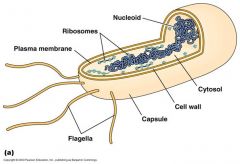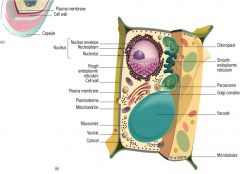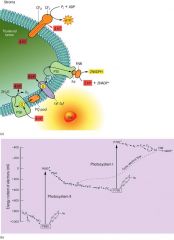![]()
![]()
![]()
Use LEFT and RIGHT arrow keys to navigate between flashcards;
Use UP and DOWN arrow keys to flip the card;
H to show hint;
A reads text to speech;
21 Cards in this Set
- Front
- Back
|
between animals, plants and other species, what differs about how atp is made?
|
the means by which proton gradients are generated and where they are generated
ex.Animal cells – mitochondrial inner membrane – proton transport during electron transport during oxidative metabolism Plant cells – in addition to mitochondrial inner membrane, the thylakoid membrane of chloroplasts – proton transport during photosynthesis Bacterial cells – a variety of means of creating proton gradients across the PLASMA membrane of the cell. The most interesting of which is a light-driven proton pump called bacteriorhodopsin |
|
|
in what species is bacteriodopsin found?
|
in archaebacteria which live in salt flats
|
|
|
what does bacteriodopsin consist of?
|
a protein and a prothestic group (retinol) imbedded in the protein
|
|
|
what happens when retinol absorbs light?
|
it will go from cis to trans
The conformational change in the retinal drives a conformational change in the entire protein, that pumps protons out of the cell, creating a proton gradient that is used by an ATP- synthase to make ATP and is also used to provide energy for the co-transport of molecules the bacterium needs to accumulate. |
|
|
when is bacteriodopson expressed and what color is it?
|
it is expressed in anerobic conditions when the atp is needed and it will color it purple
|
|
|
draw structure of bacteria
|

aa
|
|
|
the mitochondria function in _________ just as they do in animals which is to....
|
plants...which is to oxidize pyruvate to create NADH and ATP
|
|
|
function of the chloroplasts?
|
1)light reaction in the thylakoids
-Use the energy of light to split water into oxygen, protons and high energy electrons. Use some of this energy to pump protons and make ATP. Transfer the electrons to NADPH (a similar molecule to NADH used to provide reducing power in anabolic reactions) 2)Calvin cycle in the stroma -Use NADPH and ATP to reduce CO2, creating energy-rich carbohydrates for long-term energy storage |
|
|
draw picture of plant cell
|

picture
|
|
|
draw a chloroplast structure
|

stroma: fluid
membraneous sacs: thylacoids |
|
|
wavelength of visible light?
|
400-750
red being highest |
|
|
3 major pigmets in chloroplasts and what they absorb?
|
chlorophyll b: blue and orange
chlorophyll a: purple and red carotenoids: blue and green |
|
|
light exists as what?
|
photons: packets of energy
|
|
|
what happens when chlorophyll absorbs light?
|
an electron in its structure is excited, thus molecule gains energy.
this energy can be lost in one of 3 ways.... 1)lost as heat 2)resonance with another chlorophy molecule so that both molecules will split the charge 3)can be transferred to another molecule with a higher electron affinity. |
|
|
where is light normally absorbed in chloroplasts?
|
antennal chlorophyll or other pigment molecules in the thylakoid membranes of chloroplasts
|
|
|
describe the process of absorbt ions of light in thylakoid membranes
|
1)light is absorbed by antennnal chlorophyll or other pigment molecules in the thylakoid membrane of chloroplasts
2)energy is passed between antennal pigment molecules by resonance. 3)energy is eventually absorbed by chlorophyll that is part of a reaction center - P680 in PS2 - P700 in PS1 3)reaction center chlorophyll of PS2 is excited....energy of one of its electrons is bosted and high energy electron is transferred to a closely associated chlorophyll like molecule: pheophytin 4)pheophytin is now negatively charged and Ps2 is positively charged 5) P680 will grab electrons from manganese ion within the oxygen evolving enzyme complex to regain neutral charge 6) manganese ions regain their electros by withdrawing one electron from 2 waters 7) this creates O2 and 4H+ 8) the 4H+ will stay in the thylakoid lumen |
|
|
describe electron transort in the thylakoid membranes from Ps2 to Ps1
|

-process is similar to that of mitochondria in which electrons are transferred to a series of electron carriers with successively higher electron affinities
1)plastoquinone(similar to ubiquinone) 2)cytochrome enzyme complex 3)as electrons pass through carriers.....protons are pumped from stroma to the thylakoid lumen 4)proton gradient is used to synthesize ATP in the stroma by ATP synthase which allows the protons to leak back into the stroma 5) electrons finally transferred to plastocyanin which will carry the electron to photosystem 1 |
|
|
are are electrons moved in light dependent reaction of photosynthesis with respect to membrane
|
accross membrane with help of carrier molecules
|
|
|
describe how photosystem 1 operates
|
--similar to PS2
1)light harvesting complex of chlorophyll molecules transfers, by resonance, energy absorbed by photons to a reaction center chlorophyll 2)energy transferred to acceptor A0 3) P700+ recovers its electrons from plastocyanin 4)electron is transferred in chain to reduce ferridoxin (Fe-S protein) 5) reduced ferridoxin is used to reduce NADP+ to NADPH in the stroma |
|
|
overall product of Ps1 and Ps2?
|
energy of light created atp and NADPH in the stroma of chloroplast....these molecules are used to fix CO2 and reduce the products to create carbohydrates in the Calvin cycle
-light energy has been converted to a stable form of chemical potential energy---carbs |
|
|
can carbs be exported out of chloroplast to be used elsewhere in plants?
|
yes
|

